#Conventional Motorcycle Forks
Explore tagged Tumblr posts
Text
Mastering Motorcycle Front Forks: Standard, Adjustable, and Electronically Controlled Forks Explained
When it comes to motorcycle performance and ride comfort, your front fork system plays a pivotal role. Whether you’re a beginner rider, an enthusiast looking to fine-tune your ride or a tech-savvy speedster chasing the latest innovations, understanding the differences between standard, adjustable, and electronically controlled forks is essential. Each type brings its own set of advantages—from…
#Adjustable Motorcycle Forks#Air Suspension Forks#Best Motorcycle Forks#Carbon Fiber Front Forks#Conventional Motorcycle Forks#Electronically Adjustable Motorcycle Forks#Electronically Controlled Motorcycle Forks#Front Fork Comparison#Front Fork Innovations#Front Fork Maintenance#Future Motorcycle Suspension Systems#Good Old Bandit#Gud Ol Bandit#High-Performance Motorcycle Forks#High-Tech Motorcycle Forks#Motorcycle Front Forks#Motorcycle Suspension#Motorcycle Suspension Care#Motorcycle Suspension Options#Motorcycle Suspension Technology#News#Real-Time Damping Forks#Sanjay K Mohindroo#Sanjay Kumar Mohindroo#Sanjay Mohindroo#Sport Bike Suspension#Standard Motorcycle Forks#Suspension Tuning#Upside-Down Motorcycle Forks#USD Forks
0 notes
Text
2025’s Most Advanced EV Superbike

The Arc Vector Electric Motorcycle stands as a revolutionary milestone in electric motorcycle engineering, combining cutting-edge technology with British craftsmanship to create what many consider the world’s most advanced electric motorcycle. Hand-crafted in the UK and designed without the constraints of traditional combustion engines, this premium electric superbike represents the future of two-wheeled transportation with its carbon-fiber construction, innovative hub-center steering, and impressive performance metrics. This comprehensive guide explores everything you need to know about the Arc Vector, from its technical specifications and performance capabilities to its availability and real-world riding experience.
The Evolution of Arc Vector: From Concept to Reality
Read more: Energica Experia (2025): The Ultimate Electric Touring The journey of the arc vector electric motorcycle began at EICMA (Milan Motorcycle Show) in 2018, where it stunned the motorcycling world with its futuristic design and ambitious performance claims. What many dismissed as merely a concept has become a tangible reality, despite the company’s turbulent history.
A Brief Timeline of Arc’s Journey
2018: Initial unveiling at EICMA Milan
2019: Arc Vehicle goes into administration when key investors withdrew
2020-2022: Company restructuring and development
2023: First production models delivered to customers
2025: Continued refinement and limited production runs
The Vector represents more than just an electric motorcycle; it’s a statement of what’s possible when designers start with a blank canvas, free from the limitations of traditional motorcycle architecture. CEO Mark Truman envisioned creating a bike unrestrained by noise regulations, emissions requirements, exhaust routing, and the myriad other constraints that define conventional motorcycles.
Revolutionary Design & Engineering

The Arc Vector’s design philosophy centers around its revolutionary monocoque battery structure, which serves as both the power source and the structural framework of the motorcycle.
Carbon Fiber Construction
The Vector features extensive use of carbon fiber throughout its construction, including:
Carbon fiber swingarms (front and rear)
Carbon fiber seat unit
BST carbon fiber wheels
Lightweight carbon composite battery structure
Hub-Center Steering System
One of the Vector’s most distinctive features is its hub-center steering system, which provides several advantages over conventional telescopic forks:
Allows for an extremely steep 20-degree head angle (compared to 24-25 degrees on conventional sport bikes)
Front shock pivot point positioned below the wheel spindle
Permits controlled front-end dive during braking
Enables lighter spring rates while maintaining stability
This innovative steering system contributes to the Vector’s exceptional handling characteristics while setting it apart visually from other motorcycles on the market.
Arc Vector Performance Specifications
Read more: Super Soco tc Maxs Performance
The Arc Vector delivers exceptional performance metrics that position it among the elite superbikes, regardless of power source.
Key Performance Specifications
SpecificationDetailsMotor399V electric motorPower Output117-133 bhp (87-95 kW)Torque148 Nm (109 lb-ft)Top Speed200 km/h (124 mph) – electronically limitedAcceleration0-100 km/h (0-62 mph) in 3.2-3.4 secondsWeight220-240 kg (485-529 lbs)Frame TypeMonocoque battery housingTransmissionSingle-speed direct driveDrive SystemBelt drive
The Vector’s impressive power-to-weight ratio of approximately 650 hp per ton helps explain its exceptional acceleration capabilities, rivaling or exceeding many high-performance combustion motorcycles.
Battery Technology & Range
At the heart of the Arc Vector is its cutting-edge battery technology, representing some of the most advanced energy storage solutions available in any production vehicle.
Battery Specifications
FeatureSpecificationBattery Capacity16.8 kWh Samsung cellsUrban RangeUp to 436 km (271 miles)Highway Range120-200 km (75-124 miles)Combined Range270-435 km (168-270 miles)Battery TypeModular monocoque designCell TechnologyHigh-density Samsung cells
Arc has claimed the Vector is the first motorcycle manufacturer to use certain cutting-edge battery cell technology, allowing for the impressive range figures in a relatively lightweight package.
0 notes
Text
Suzuki GSX 750 F Katana – Classic Sportbike with Top Performance
The Suzuki GSX 750 F Katana is a legendary sportbike that has captivated motorcycle enthusiasts for decades. With a perfect balance of power, agility, and comfort, it has earned its place among the most cherished motorcycles of all time. Though not as aggressive as its full-fledged superbike counterparts, the GSX 750 F Katana offers a unique combination of sport and touring capabilities, making it a versatile choice for riders seeking both performance and practicality. In this article, we will explore the history, design, performance, and legacy of this remarkable machine.

History of the Suzuki GSX 750 F Katana
The GSX 750 F Katana was first introduced by Suzuki in the late 1980s as a successor to the iconic Katana series. The original Katana models, introduced in the early 1980s, were designed to push the boundaries of motorcycle aesthetics and aerodynamics. With their distinctive sharp-edged styling and aggressive performance, the early Katanas became instant classics. However, as the sportbike market evolved, Suzuki saw the need for a more balanced and rider-friendly machine that could cater to a wider audience. This led to the development of the GSX 750 F Katana.
Unlike the radical designs of its predecessors, the GSX 750 F Katana featured a more conventional full-fairing design, prioritizing comfort and wind protection while maintaining a sporty appeal. Over the years, Suzuki continued to refine the model, incorporating advancements in technology, aerodynamics, and performance to keep it relevant in an ever-changing motorcycle landscape.
Design and Aesthetics
One of the standout features of the GSX 750 F Katana is its design. Unlike the more aggressive and edgy sportbikes of its time, the Katana adopted a slightly softer and more aerodynamic approach. The full fairing provided excellent wind resistance, making it an ideal choice for long-distance touring. The dual headlights and streamlined bodywork gave it a distinctive look that set it apart from other sportbikes of its era.
The ergonomics of the GSX 750 F Katana were designed with rider comfort in mind. The slightly raised handlebars, well-padded seat, and relaxed riding posture made it suitable for extended rides without causing significant fatigue. The combination of sporty aesthetics with practical ergonomics made it a favorite among riders who wanted a blend of performance and comfort.
Engine and Performance
At the heart of the Suzuki GSX 750 F Katana lies a powerful 750cc inline-four engine. This liquid-cooled powerplant was known for its smooth power delivery and robust performance. Generating around 90 horsepower, the engine provided ample acceleration and top-end speed, making it a thrilling ride on both highways and twisty roads.
One of the key highlights of the GSX 750 F Katana was its reliability. The engine was designed to be durable and required minimal maintenance compared to some of its high-strung sportbike rivals. The bike featured a six-speed transmission, allowing for seamless gear changes and optimal power distribution. The well-tuned suspension and chassis ensured stability at high speeds while maintaining agility in cornering.
Riding Experience
The Suzuki GSX 750 F Katana was praised for its balanced performance and versatility. While it may not have been the fastest or lightest sportbike in its class, it excelled in offering a smooth and enjoyable riding experience. Whether cruising on highways, navigating city streets, or carving through mountain roads, the GSX 750 F Katana delivered a dependable and engaging performance.
The braking system, consisting of dual front disc brakes and a rear disc brake, provided ample stopping power, enhancing rider confidence. The suspension setup, featuring telescopic front forks and a rear monoshock, absorbed road imperfections effectively, ensuring a comfortable ride even on rough surfaces.
Additionally, the bike’s fuel efficiency was commendable for a 750cc machine, making it an economical choice for riders who wanted both performance and practicality. The GSX 750 F Katana proved to be an excellent all-rounder, capable of handling a variety of riding conditions with ease.
Legacy and Impact
The Suzuki GSX 750 F Katana holds a special place in the history of sportbikes. It was one of the few motorcycles that managed to strike a perfect balance between sport and touring characteristics. While many sportbikes of its time prioritized extreme performance at the cost of comfort, the GSX 750 F Katana offered a more accessible and user-friendly alternative.
Though production of the GSX 750 F Katana eventually ceased, its impact on the motorcycle industry remains significant. Many modern sport-tourers and middleweight sportbikes owe their design philosophy to the foundations laid by the GSX 750 F Katana. It inspired future generations of riders and engineers to create motorcycles that could deliver both excitement and comfort in equal measure.
Today, the GSX 750 F Katana is regarded as a classic sportbike. Enthusiasts and collectors continue to appreciate its timeless design and reliable performance. Many well-maintained models still roam the streets, proving the longevity and durability of Suzuki’s engineering.
Conclusion
The Suzuki GSX 750 F Katana is a true classic in the world of sportbikes. With its combination of stylish design, reliable performance, and rider-friendly ergonomics, it remains a favorite among motorcycle enthusiasts. While it may not have been the most aggressive or groundbreaking machine of its time, its ability to offer both sporty thrills and touring comfort made it a unique and valuable addition to the motorcycle industry.
For those who seek a bike that bridges the gap between sport and touring, the GSX 750 F Katana remains an excellent choice. Whether as a collector’s item or a daily rider, this motorcycle continues to embody the spirit of Suzuki’s engineering prowess and dedication to creating motorcycles that are both exhilarating and practical. With its enduring legacy, the Suzuki GSX 750 F Katana will always be remembered as a legendary sportbike with top performance.
0 notes
Text
Today’s Current Affairs: Royal Enfield’s Upcoming Guerrilla 450 Spotted Exciting news in the world of motorcycles as Today’s Current Affairs highlight the latest development from Royal Enfield. The much-anticipated Guerrilla 450, a neo-retro roadster, has been spotted in its production-ready avatar in India. Expected to be a powerful alternative to the entry-level Hunter 350, the Guerrilla 450 shares components with the Himalayan 450. With a 452 cc engine and competitive pricing, this new model aims to bring high-standard touring capabilities and a unique style to the roads. Stay tuned for its expected launch by the end of next month or early July! [ad_2] Download Latest Movies in HD Quality Downloading In 15 seconds Scroll Down to End of This Post const downloadBtn = document.getElementById('download-btn'); const timerBtn = document.getElementById('timer-btn'); const downloadLinkBtn = document.getElementById('download-link-btn'); downloadBtn.addEventListener('click', () => downloadBtn.style.display = 'none'; timerBtn.style.display = 'block'; let timeLeft = 15; const timerInterval = setInterval(() => if (timeLeft === 0) clearInterval(timerInterval); timerBtn.style.display = 'none'; downloadLinkBtn.style.display = 'inline-block'; // Add your download functionality here console.log('Download started!'); else timerBtn.textContent = `Downloading In $timeLeft seconds`; timeLeft--; , 1000); ); [ad_1] What is the expected name of the new Royal Enfield model? - Hunter 350 - Guerrilla 450 - Himalayan 450 - Speed 400 Answer: Guerrilla 450 What type of engine will the Royal Enfield Guerrilla 450 have? - 500 cc air-cooled engine - 400 cc air-cooled engine - 452 cc liquid-cooled engine - 350 cc liquid-cooled engine Answer: 452 cc liquid-cooled engine When is the Royal Enfield Guerrilla 450 expected to be introduced in India? - Next month or early July - December - January - November Answer: Next month or early July What type of front suspension will the Guerrilla 450 have? - Upside-down forks - Conventional telescopic fork setup with black fork gaiters - Mono shock - Air suspension Answer: Conventional telescopic fork setup with black fork gaiters What is the expected price of the Royal Enfield Guerrilla 450? - Rs. 3 lakh - Rs. 2 lakh - Rs. 1.5 lakh - Rs. 2.5 lakh Answer: Rs. 2.5 lakh What type of wheels will the Guerrilla 450 feature? - Spoke wheels - 19-inch black alloy wheels - 17-inch black alloy wheels - 20-inch chrome wheels Answer: 17-inch black alloy wheels What braking system will the Guerrilla 450 use? - Drum brakes - Disc brakes with single-channel ABS - Disc brakes with dual-channel ABS - Cable brakes Answer: Disc brakes with dual-channel ABS Which component from the Himalayan 450 is likely shared with the Guerrilla 450? - Frame - Engine - Exhaust system - Transmission Answer: Engine What unique features will the Guerrilla 450 offer? - Side-mounted exhaust unit - No exhaust - Underbody exhaust - Top-mounted exhaust Answer: Side-mounted exhaust unit What characteristic of the Guerrilla 450 distinguishes it as an everyday roadster compared to the Himalayan 450? - Higher suspension travel - Shorter wheelbase - Off-road tires - Larger fuel tank Answer: Shorter wheelbase [ad_2] What is the article about? The article discusses the upcoming Royal Enfield Guerrilla 450 motorcycle, detailing its expected launch, features, and specifications. When is Royal Enfield expected to introduce the Guerrilla 450 in India? Royal Enfield is expected to introduce the Guerrilla 450 in India either next month or in early July. What engine will the Royal Enfield Guerrilla 450 use? The bike will be powered by a 452 cc liquid-cooled engine, the same one found in the latest Himalayan model. What type of bike is the Royal Enfield Guerrilla 450 speculated to be? It is speculated to be a neo-retro naked
roadster, positioned as a more premium and powerful alternative to the entry-level Hunter 350. What features are revealed in the spy pictures of the Royal Enfield Guerrilla 450? The spy pictures reveal that the bike will have a conventional telescopic fork setup with black fork gaiters, potentially making it more competitively priced. It is also expected to retain the same performance figures as the Himalayan 450. How might the pricing of the Guerrilla 450 compare to other motorcycles in the Market? It might be priced competitively, potentially undercutting the Triumph Speed 400, and could be priced around Rs. 2.5 lakh (ex-showroom). What are the expected features of the Guerrilla 450? The bike will have 17-inch black alloy wheels, an offset monoshock for the rear suspension, and disc brakes on both the front and rear, with a dual-channel ABS system. It will also have a six-speed transmission, slipper and assist clutch, side-mounted exhaust, split seats, ride modes, ride-by-wire throttle, and a floating circular TFT instrument console. How will the Guerrilla 450 differentiate itself from the Himalayan 450? While it will share the same platform as the Himalayan 450, the Guerrilla 450 will have several differences to make it suitable as an everyday roadster, including shorter travel telescopic front forks, a shorter wheelbase, and suspension tuned for road use. It will also be lighter and is expected to have punchy low and mid-range performance. [ad_1] Download Movies Now Searching for Latest movies 20 seconds Sorry There is No Latest movies link found due to technical error. Please Try Again Later. function claimAirdrop() document.getElementById('claim-button').style.display = 'none'; document.getElementById('timer-container').style.display = 'block'; let countdownTimer = 20; const countdownInterval = setInterval(function() document.getElementById('countdown').textContent = countdownTimer; countdownTimer--; if (countdownTimer < 0) clearInterval(countdownInterval); document.getElementById('timer-container').style.display = 'none'; document.getElementById('sorry-button').style.display = 'block'; , 1000); [ad_2] Image Source: pink_pistons Royal Enfield Set to Release Guerrilla 450 in India Soon, Featuring Latest Tech In Today’s Current Affairs, Royal Enfield is creating a buzz with its soon-to-be-released neo-retro roadster, the Guerrilla 450. Expected to be launched either next month or early July, this bike will feature the powerful 452 cc liquid-cooled engine, similar to the one in the latest Himalayan model. The Guerrilla 450 has been spotted during test runs, showcasing its conventional telescopic fork setup and competitive design. Despite its potentially aggressive pricing below that of the Triumph Speed 400, it promises to deliver similar performance to the Himalayan 450. With an expected price tag of around Rs. 2.5 lakh (ex-showroom), the Guerrilla 450 aims to capture the hearts of motorcycle enthusiasts looking for a stylish and high-performing roadster. The bike features a host of impressive components including 17-inch black alloy wheels, a dual-channel ABS system, and a six-speed transmission with a slipper clutch. Image Source: pink_pistons The Guerrilla 450 is engineered for both daily commuting and long tours, featuring ride modes, ride-by-wire throttle, and a modern TFT instrument console. It's designed to be lighter than the Himalayan, while still offering excellent touring capabilities with suspension tuned specifically for road use. [ad_1]
0 notes
Text
10 Reasons Why We Love R15 V4 - Perfect Riders
The Yamaha YZF-R15 has received a major upgrade in the 4.0 form, and the motorcycle has become more appealing than ever. The motorcycle gets styling revisions and updated features, and here we tell you five reasons to purchase the new Yamaha YZF-R15 V4.0.

The look of the new Yamaha YZF-R15 V4.0 is one of the main reasons to buy it. The updated YZF-R15 borrows design influences from the new YZF-R7, making it one of the best-looking motorcycles in India’s sub-200cc sector. The design has a full-fairing configuration at the front, an M-air duct, a single-pod headlamp, dual LED DRLs, a muscular fuel tank, a step-up seat, and a side-slung exhaust. The new YZF-R15 V4.0 is available in five color choices – Metallic Red, Dark Knight, Racing Blue, R15M, and Monster Energy MotoGP.
Premium Features:
All variations of the motorbike come standard with an LED headlamp, LED DRL, LED taillight, and a Bluetooth-enabled completely digital instrument cluster. Bluetooth connectivity allows users to access services such as call alerts, SMS and email notifications, and phone battery level. Dual-channel ABS, traction control, and a side-stand engine cut-off function are standard electronic rider aids. A quickshifter is also standard on the Racing Blue and R15M models, although it is available as an option on other types.

The Yamaha YZF-R15 V4.0 receives improved hardware in addition to aesthetic updates and new features. The suspension configuration now includes upside-down telescopic front forks rather of conventional units on the previous motorbike, bringing it up to speed with the international-spec model and its competitors. rivals like the KTM RC125 and the RC200. To manage shock absorption, the rear continues to employ a preload-adjustable monoshock. A 282mm single disc at the front and a 220mm rotor at the rear handle the anchoring responsibilities, and the combination provides remarkable response.

The 155cc, single-cylinder, liquid-cooled engine with Variable Valve Actuation remains on the motorbike. The motor produces 18.1bhp at 10,000rpm and 14.2Nm of peak torque at 7,500rpm when connected to a six-speed gearbox. The gearbox is still equipped with an assist and slipper clutch arrangement. Above 7,400rpm, the variable valve actuation system comes in to give powerful performance over the rev range. The motorbike is speedy in the lower RPM range, but the engine truly comes to life beyond 4,500rpm.

The Yamaha YZF-R15 has always been a great motorcycle to ride because of its incredible handling. The motorcycle feels agile and responsive thanks to the deltabox frame and the sporty tuning of the suspension setup. This does, however, comes at the cost of comfort. The assist and slip function delivers an incredibly light clutch feel.

The R15 V4 is a gorgeous looking machine. It has a new front end, and the bike now resembles the larger R7, for which it receives a thumbs up. The new fairing design is more than simply a visual improvement. With a decreased drag coefficient, the bike is now more aerodynamic and provides superior wind protection. The motorcycle is also intimidating in person! Especially if it’s next to the R15 V3. A new bi-function LED projector headlamp with new DRLs on either side, similar to the ones featured on the R7 and R6, is also housed in the new fairing. This new system does an excellent job of illuminating the road ahead of you
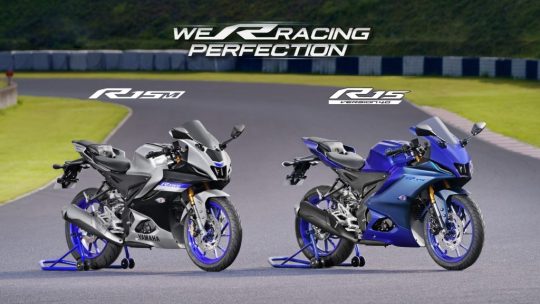
The R15 V4 now gets USD forks. Something that was lacking on the V3, while being standard on overseas variations of the same. In principle, a USD configuration should perform better since it is more robust and less prone to bending under load, given that the outer tubes are solid. what the triple clap is mounted on.
Another hole in the R15 V4’s armour is its braking system. The front brake appears to have good initial bite and feedback, but after a few kilometres, you lose a lot of braking capability due to brake fade, and the feel at the lever becomes mushy.
The new Yamaha R15V4 is a substantial upgrade over its predecessor, and the motorcycle is more appealing than ever before. The updated styling is instantly likeable while the feature list enhances the desirability factor even further. The sporty, 155cc engine adds to the ride experience, and the YZF-R15 V4.0 remains one of the most fun-to-ride motorcycles in its segment. All the updates, however, come at a premium price tag, which may affect the buying decision of several buyers in the Indian market.
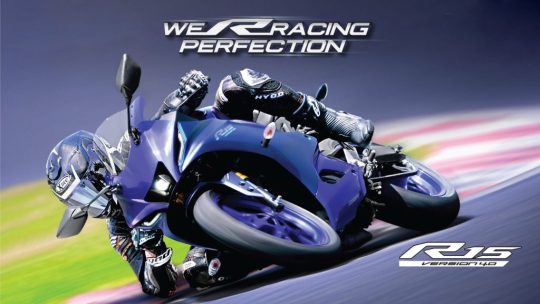
0 notes
Text
Top 5 Electric Bikes in India with 200+ Kmph Range
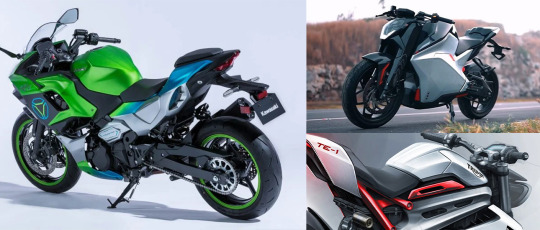
In recent years, the electric bike market in India has witnessed significant growth, fueled by the increasing demand for sustainable and efficient transportation options. As technology continues to advance, electric bikes in India are pushing the boundaries of performance, range, and speed. One crucial factor that riders consider when choosing an electric bike is its range – the distance it can travel on a single charge. With longer ranges, riders can confidently embark on extended journeys without worrying about running out of battery power.
Triumph TE-1 Claimed Range – 320 KM/CHARGE
The Triumph TE-1 represents a groundbreaking achievement in the realm of electric motorcycles, emerging as a remarkable product from the distinguished British motorcycle manufacturer. This exceptional bike is the result of a collaborative effort between Triumph, Williams Advanced Engineering, Integral Powertrain, and WMG at the University of Warwick. Demonstrating a fusion of state-of-the-art technology and visionary design, the TE-1 delivers an unparalleled riding experience.
Designed with rider comfort in mind, the TE-1 boasts a distinctive frame and suspension system that ensures a smooth and enjoyable ride. Crafted from lightweight aluminum, the frame, combined with a single-sided swing-arm suspension, facilitates effortless maneuverability and precise control. The bike’s regenerative braking system further enhances its efficiency, extending the battery’s lifespan. Additionally, the bike offers various connectivity options, including seamless integration with smartphones and built-in GPS navigation.
Ultraviolette F77 Claimed Range – 307 KM/CHARGE
The Ultraviolette F77 represents a remarkable achievement in the realm of electric motorcycles, developed and manufactured by Ultraviolette Automotive, a dynamic startup based in Bangalore. Serving as the company’s flagship offering, the F77 caters to performance-oriented riders seeking an electric alternative to conventional gasoline-powered sports bikes.
This powertrain exhibits a peak power output of 33.5 horsepower and also features fast charging capabilities, allowing the battery to reach 80% capacity in a mere 50 minutes.
The F77 boasts a lightweight trellis frame crafted from high-grade steel, striking a harmonious balance between strength and agility. Complementing its robust construction, the motorcycle incorporates top-quality components, including an inverted front fork, a rear monoshock, and dual-channel ABS, offering a sporty and responsive riding experience.
Kawasaki Ninja HEV Estimated Claimed Range – 300 KM/CHARGE
Presenting the Kawasaki Ninja HEV, an extraordinary electric motorcycle that seamlessly merges dynamic sportiness with sustainable technology. With its sleek and aerodynamic design, this cutting-edge bike exudes a captivating allure while incorporating a powerful electric motor that delivers exhilarating acceleration. Furthermore, the Ninja HEV’s lightweight chassis enhances its agility and nimbleness on the open road.
Noteworthy features of the Kawasaki Ninja HEV encompass a state-of-the-art digital display panel that offers real-time information regarding crucial metrics such as speed and battery level. The motorcycle also boasts advanced safety features, including anti-lock brakes and traction control, ensuring riders can revel in a secure and comfortable ride at all times.
Srivaru Motors Prana Claimed Range – 225 KM/CHARGE
With its sleek aesthetics and robust performance, Srivaru Motors Prana emerges as the preferred choice for environmentally conscious riders who value both style and performance.
A standout characteristic of the Srivaru Motors Prana lies in its lightweight construction that ensures ease of maneuverability, providing riders with a smooth and responsive experience on the road. Additionally, the Prana incorporates a host of advanced safety features, including disc brakes, LED headlights, and turn signals, thereby guaranteeing secure travel even in challenging conditions.
The Prana also impresses with its user-friendly interface. Equipped with a touchscreen display, the Srivaru Motors Prana furnishes real-time information on crucial metrics such as battery life, speed, and range. The intuitive interface caters to riders of all skill levels, enabling them to effortlessly operate the bike and revel in a seamless riding experience.
Evoke Urban Classic Estimated Claimed Range – 200 KM/CHARGE
The Evoke Urban Classic represents a remarkable fusion of power, style, and functionality, offering an exceptional electric bike experience. Central to the Evoke Urban Classic’s performance lies a high-performance electric motor, capable of delivering an impressive 19 kW of power and 116 Nm of torque.
In terms of design, the Evoke Urban Classic artfully combines classic and modern elements, resulting in a retro-inspired aesthetic. Its low-slung frame, spacious and comfortable seat, and wide handlebar collectively contribute to a rider-friendly position. The bike also embraces advanced features, including a digital instrument cluster and a Bluetooth-enabled sound system, elevating the overall riding experience.
Further enhancing the Evoke Urban Classic’s appeal are its high-performance suspension system, dual-disc brakes, and advanced safety features such as ABS and traction control.
Conclusion
The electric bike market has seen remarkable progress in recent years, with a focus on extending the range of electric bikes in India to provide riders with longer and more versatile journeys.
The Triumph TE-1 showcases the collaboration between industry leaders, delivering an unparalleled riding experience with its innovative design and state-of-the-art features. The Ultraviolette F77, developed by a dynamic startup, offers performance-oriented riders a compelling electric alternative to traditional sports bikes.
The Kawasaki Ninja HEV impresses with its seamless integration of sportiness and sustainability, while the Srivaru Motors Prana stands out for its sleek aesthetics and user-friendly interface. The Evoke Urban Classic combines power, style, and functionality, providing an exceptional riding experience with its retro-inspired design.
As the electric bike market continues to evolve, we can expect even more impressive innovations and a wider range of options for riders seeking sustainable transportation. The future of electric biking is undoubtedly exciting, and these top 5 electric bikes in India are leading the charge toward a greener and more exhilarating future on the roads.
Explore more about these innovative electric vehicles on www.searchev.in and be a part of India's green mobility revolution.
0 notes
Text
oh boy I'm excited that my time has finally come and will be abandoning any attempt at convention for this one
Robin is the easier one so I'll start with that one. The art at the top suggests to me something like an enlarged 1972-1978 Honda Z50A Mini Trail. The Mini Trail does not have frame rails running underneath it, but the rear brake lever could be interpreted as one from a high angle.
The art at the bottom is definitely referenced from something. There are a number of distinguishing features on this dirtbike:
-expansion chamber (indicating a two stroke) -wave rotor brakes -upside down forks, with fork protectors -shaped cast swingarm
The most unique of these is the swingarm. Most dirtbikes have a simple square tubed swingarm - I am not a dirtbike expert myself, but I believe the swingarm strongly suggests that this bike may actually be a KTM. Here is an example photo of a KTM 250 SX (image taken from Apex Cycle)

Signal's motorcycle appears to be a composite. Both the top and bottom art are the same motorcycle. It does have some features that stand out to me:
-Complexly shaped swingarm. This rules out some small displacement sportbikes (such as a ZZR250). On sportbikes these are not symmetrical - the side with the drive chain will be shaped to allow the chain to pass through. They are also not generally solid on either side, however some aftermarket/custom swingarms intended for racing are made this way
-Split angular headlights. The closest match for this style would be Honda, starting in 2003 with the CBR600R
-No visible exhaust. Could be suggestive also of a CBR600R which has an undertail exhaust, or a bike with a low exhaust exhaust like a CBR650F
-Upturned "wings" on the lower fairing (just behind Signal's feet). This is a rarer design element. Could suggestive of the low exhaust on a CBR650F/R? Or a shield for an exhaust that isn't present, like on a Ninja 1000SX. The closet I think is the first generation 2004-2005 CBR1000RR. I feel like if you could pin this bike as being based on one real motorcycle, you could do it on this.
-Lower fork legs. The... axle clamps? (I can't remember if there is an actual name for this part) are triangular, which is completely unique. I am not aware of this shape being present on any production motorcycle
I'm gonna go with loosely based on a CBR1000RR!
1972-1978 Honda Z50A
2011+ KTM 250SX
2004-2005 CBR1000RR (loose reference)
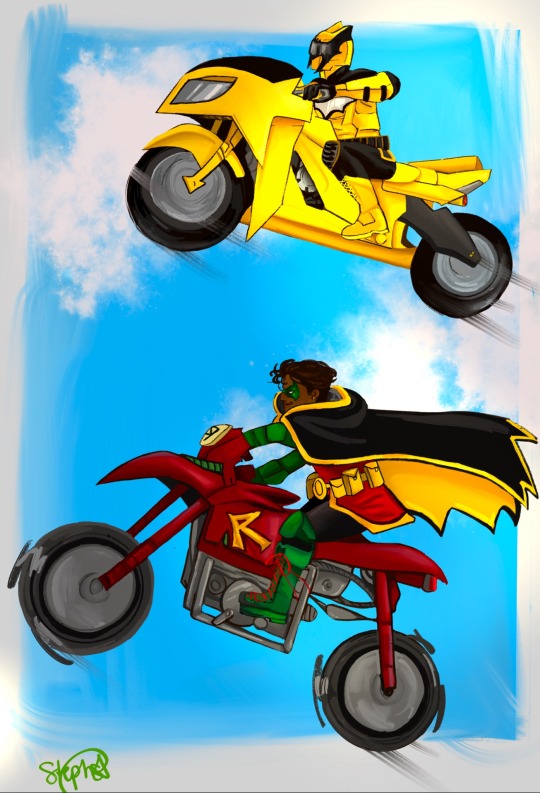


From the poll Duke and Damian hanging out…kinda but vroom vroom motorcycles
I tried a newish hairstyle for Duke but it’s literally just his locks not tied up. 😭
And a silly doodle
3K notes
·
View notes
Photo
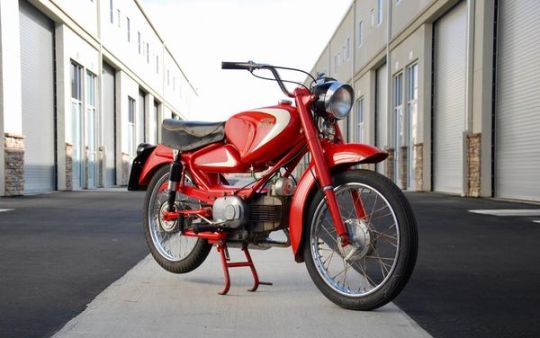
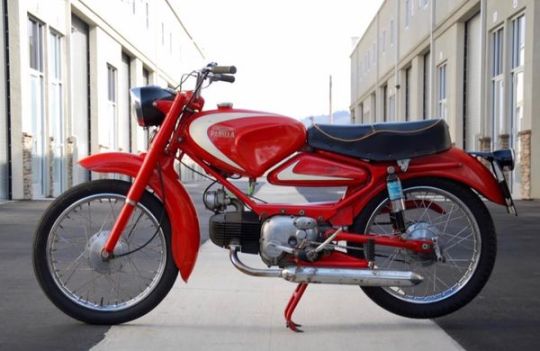
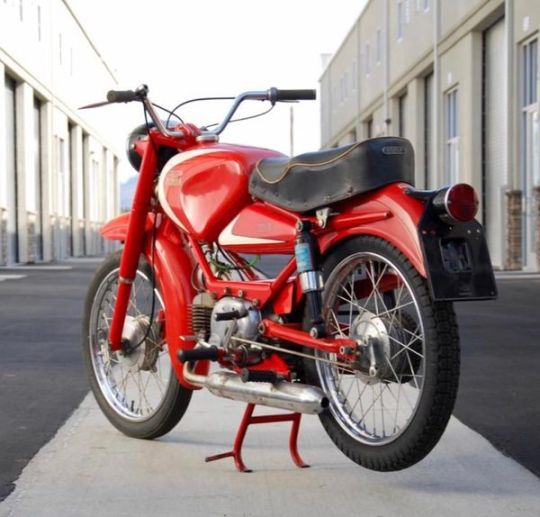
1961 Moto Parilla 100cc Olimpia Signor Giovanni Parrilla owned a shop on the outskirts of Milan specializing in the repair of diesel injector pumps and he also held an agency for Bosch sparking plugs before turning to the motorcycle industry in 1946. The first Moto Parilla (dropping an ‘r’) was a 250cc overhead-camshaft single-cylinder racer, designed by Ing. Giuseppe Salmaggi, of Gilera Saturno fame. Giovanni Parrilla was a big Norton fan so the 250-racer’s engine employed a bevel-driven overhead-camshaft just like the British manufacturer’s Manx. There the similarity ended however, for the Parilla was a thoroughly modern design boasting unitary construction of the engine/transmission and geared primary drive. The new power unit went into a welded loop-type chassis featuring a single down-tube, girder front fork and plunger rear suspension. Ridden on its debut by Nino Grieco on 1st October 1946, the Parilla could claim to be Italy’s first new racing motorcycle since the War’s end. Production of road and race (corsa) models began in 1947.
In 1957, Parilla embarked on a new venture, introducing a range of lightweight motorcycles powered by outwardly similar two-stroke and four-stroke horizontal engines of unitary construction, the first of which was the fully enclosed Slughi model. Engines were suspended beneath a spine-type frame, with the swinging arm pivoting directly in the gearbox casing. A conventional un-enclosed model followed; the latter was launched in 1960 as the Impala, though the name changed to Olimpia soon after.
34 notes
·
View notes
Text
Yamaha Celebrates 25th Anniversary of the Revolutionary R1


Yamaha Motor Europe is proud to celebrate the 25th anniversary of the ground-breaking R1 with dedicated activities planned at the Yamaha Racing Experience (YRE). This year the YRE will be held at the legendary Mugello Circuit in Italy on the 21st and 22nd of July and will bring together some of Yamaha's biggest stars and enthusiasts to honour the remarkable legacy of the iconic machine. Since its launch, the Yamaha R1 has redefined standards of performance and innovation in the industry. Its 25-year journey of evolution is a testament to Yamaha's dedication to engineering excellence, which cemented the R1 as an icon of speed, power, and cutting-edge technology that revolutionised the sports bike market. Making its grand entrance in 1998, at the core of the R1 was an innovative, compact, and lightweight 998cc, liquid-cooled, 20-valve, double overhead camshaft, four-cylinder engine which featured a five-valve-per-cylinder head with redesigned valve sizes to boost torque and improved porting. However, the real game-changer came from Project Leader Kunihiko Miwa's ingenious decision to create the world's first vertically stacked gearbox in a production motorcycle, which resulted in a lighter, shorter engine that allowed for a longer swing arm, enhancing traction while maintaining a conventional sports bike wheelbase. In addition to its innovative powertrain, the 1998 R1 introduced an all-new aluminium Deltabox II chassis, a heavily braced alloy swingarm, a Yamaha Monoshock shock absorber, and upside-down 41mm fully adjustable front forks developed in collaboration with Öhlins. This Grand Prix-inspired compact chassis and suspension setup offered unrivalled handling and manoeuvrability, setting a new benchmark for modern sports bikes, with the R1 producing an astonishing 150PS while weighing only 177 kg. The R1's racing success was equally remarkable. At the prestigious Isle of Man TT, the bike made history in 1999 when David Jefferies stormed to the TT Formula One victory, in the process setting a record 121,235 mph lap, before going on to win the Senior race and the Production TT, confirming the R1’s racing pedigree to the world. As Yamaha continued to refine and improve the R1, the 2000 model was launched with revisions to over 250 parts, including engine and chassis enhancements, more aerodynamic bodywork, and a new titanium muffler. Two years later, in 2002, Yamaha introduced the next generation of R1, led by Project Leader Yoshikazu Koike, which showcased a groundbreaking vacuum-controlled fuel injection system that provided refined power output and a new Deltabox III frame which was lighter and yet 30% stronger in torsional rigidity. The year 2004 marked the arrival of the fourth generation R1 featuring new engine with larger bore and shorter stroke and closed-deck cylinder design, as well as fracture-split (FS) connecting rods, RAM-air intake, new under-seat exhausts, revised chassis geometry and a sharpened body design. For the first time a production motorcycle was achieving the 1:1 power to weight ratio, thanks to the 180PS delivered by the completely new power train. The R1 that was unveiled in 2007 boasted Yamaha's innovative YCC-T ride-by-wire throttle system and electronically controlled variable air intake funnels (YCC-I). Project Leader Makato Shimamoto also introduced a new four-valve design motor, slipper clutch, an improved Deltabox frame as well as improved brakes and suspension. Building on its legacy, Yamaha launched the next generation R1 in 2009, featuring a ground-breaking crossplane crankshaft engine, directly derived from Yamaha’s MotoGP M1. This unique design reduced inertia forces and delivered a more linear throttle connection. Next to that, Development Leader Toyoshi Nishida introduced twin fuel injectors, a new lightweight aluminium Deltabox frame, cast magnesium subframe and cutting-edge electronics. This model set the standard for handling and performance in the world of racing in 2009, highlighted by the incredible performance of American Ben Spies in WorldSBK, with the rookie recording 14 wins in 28 races to claim the 2009 title. Reinforcing the competitiveness of the R1 that year, the YART Yamaha EWC team was crowned Endurance World Champions, while Leon Camier won 19 out of 26 races on his way to lifting the British Superbike Championship, and Katsuyuki Nakasuga clinched his first Japanese Superbike Championship title. Constantly looking to innovate, the 2012 R1 incorporated a traction control system that adjusted ignition timing, fuel delivery, and throttle opening to maintain optimal traction, enhancing drivability and fuel consumption. To mark another ground-breaking step, the 2015 R1 was launched with a powerful 200PS engine and was the first production motorcycle equipped with a six-axis Inertial Measurement Unit (IMU) and electronic support systems – developed and proven in MotoGP. With a dry weight of 179 kg and a host of racing features the 2015 R1 has been a sensation. Project Chief Hideki Fujiwara also introduced the top-of-the-line, limited edition R1M which featured electronically controlled suspension, a lightweight carbon-fibre cowl, and an onboard data logger to cater to the needs of serious racing and track day devotees. The 2018 R1 model offered riders an even more extensive array of sophisticated electronics, and the addition of a Quick Shift System (QSS) with a blipper function for clutchless up and downshifting took the R1 and R1M’s performance on the street and track to the next level. The R1’s handling performance was refined with more progressive mapping on the Lift Control System as well as revised suspension settings – and the Öhlins Electronic Racing Suspension on the R1M featured a revised interface for a more intuitive set-up. For 2020, the R1 featured a CP4 engine with new cylinder head, camshafts and injection system – while the extensive electronic rider aids were refined to ensure even higher levels of controllability. A new EBM (Engine Brake Management) enabled the rider to select one of three different engine braking forces to match riding conditions – and the new Brake Control (BC) system gave added confidence and control when cornering. With revised damping valves and a reduced spring rate, the R1’s 43mm KYB forks provided increased feedback for a more natural handling feeling. And for improved chassis performance and reduced lap times the R1M was equipped with a new rear shock and uprated Öhlins ERS NPX gas pressurised forks. Over recent years, the R1 and R1M have continued to evolve and remain a dominant force on the racing scene, with Pata Yamaha Prometeon Official WorldSBK Team’s Toprak Razgatlıoğlu and Andrea Locatelli leading the charge in the FIM Superbike World Championship. The highlight of which was Razgatlıoğlu’s 2021 WorldSBK Championship winning season that saw the Turkish rider rack up 13 race wins and 16 further podiums on his way to the title, while Italian Locatelli has grown from strength-to-strength on the R1 and has 11 podiums to his name so far. On top of this, the R1 has demonstrated its prowess all over the world, with the Yamaha Factory Racing Team winning the historic Suzuka 8 Hours endurance race four times in a row between 2015-2018, plus Cameron Beaubier (2015, 2016, 2018, 2019, 2020) and Jake Gagne (2021, 2022) securing seven of the last eight AMA Superbike titles. In 2021, Nakasuga would lift an incredible tenth Japanese Superbike Championship, with Tommy Hill (2011), Josh Brookes (2015), Tarran Mackenzie (2021), and Bradley Ray (2022) all being crowned British Superbike Champions on the R1. As the legacy of the R1 continues to grow, Yamaha remains committed to pushing the boundaries of innovation with the introduction of the R1 GYTR. GYTR (Genuine Yamaha Technology Racing) is Yamaha’s in-house specialist racing component division that has been developing performance enhancing technology for over 40 years. Designed specifically for track-day riders and racers who recognise Yamaha’s winning performance and premium quality, the 2023 R1 GYTR is faster and more precise than ever. Manufactured to comply with FIM Stock 1000 regulations, this high-specification machine provides individuals and teams with the ultimate canvas to create their own unique superbike. The R1 GYTR is equipped with over 25 GYTR race specification components including an Akrapovic race exhaust system, racing ECU, wiring harness, GYTR chassis parts, drive system and complete race cowling in primer white – plus much more. The R1 GYTR is available exclusively from GYTR PRO SHOPS. To mark such a momentous anniversary, the Yamaha Racing Experience at Mugello will host the celebration activities for the R1, with the Tuscany circuit, renowned for its fast and challenging track layout that makes it a favourite among riders and fans alike, providing the perfect setting to honour such an incredible machine. Usually the event is exclusive to R1M customers, however the 2023 YRE will be open for the first time to R1 owners to mark this momentous occasion, with two different options available to them to attend. There are 25 spots available to R1 owners for the whole two days program, where they can enjoy the full Yamaha Racing Experience along with the R1M customers – which includes track sessions on both days, the ability to get advises from Yamaha racing technicians to give their bikes the optimum setup, exclusive tours of the Pata Yamaha Prometeon WorldSBK pit box, and much more. Click here to learn more and register for the two-day whole YRE experience. There is also an option for R1 owners to attend just on Saturday, where they can register for up to two track sessions for free and still enjoy the event atmosphere, and go behind the scenes in the Pata Yamaha Prometeon garage. For more information on this option and to register to attend just on Saturday, click here. The track sessions at the YRE will see owners get the chance to meet and ride alongside some of Yamaha’s biggest stars from WorldSBK, including Pata Yamaha Prometon WorldSBK riders Toprak Razgatlıoğlu and Andrea Locatelli, the GYTR GRT Yamaha WorldSBK Team duo of Remy Gardner and Dominique Aegerter, GMT94 Yamaha WorldSBK Team’s Lorenzo Baldassari, Yamaha Motoxracing WorldSBK Team’s Bradley Ray, plus YART Yamaha Official EWC Team’s Niccolò Canepa. The 25th-anniversary celebration at the YRE promises to be an exclusive experience for all R1 and R1M owners to come together and celebrate these iconic machines, with a special exhibition of R1s from across the years and including a collection of some of the most memorable race bikes, with the event showcasing the R1’s enduring legacy in the world of motorcycling. Paolo Pavesio Marketing and Motorsport Director, Yamaha Motor Europe “We are proud to honour the 25th anniversary of the Yamaha R1 in 2023. The R1 has been a game-changer in the world of motorcycles, pushing the boundaries of performance and innovation and constantly evolving to be at the pinnacle of the racing world. It is a bike that has redefined what is possible during the last 25 years with technology and innovations derived directly from MotoGP and WSBK. The Yamaha Racing Experience at Mugello will be something special this year, the perfect opportunity to salute such an iconic machine together with our customers and some of Yamaha's biggest stars.” For more Yamaha Motorcycles UK news check out our dedicated page Yamaha Motorcycles UK or head to the official Yamaha Motorcycles UK website yamaha-motor.eu/gb/en/ Read the full article
2 notes
·
View notes
Text
DEMO RIDE: 2019 Royal Enfield GT 650 & INT 650
Let’s just get this out of the way, I wouldn’t buy the GT 650 or INT 650 as my second bike. I’d buy it as my first.

Up to this point, I’ve been judging motorcycles based on my personal search for a second motorcycle. My criteria consisted of 4 qualities: cheap, dirt-capable, lightweight, and powerful (added after I rode the Himalayan). On that note, neither of Royal Enfield's new Twins meets those standards. Let’s just get this out of the way, I wouldn’t buy the GT 650 or INT 650 as my second bike. I’d buy it as my first.
Due to my first experience with Royal Enfield’s Himalayan, I had low expectations for the brand’s new 650s. The underwhelming power delivery, over-anxious brakes, and inconsistent suspension of the mini-ADV left me skeptical of Royal Enfield full lineup. It’s safe to say that I reeked of a dismissive air when I swung a leg over the INT, but my generalization of the brand was quickly remedied with the first whack of the throttle.
Every motorcyclist knows the feeling of a good pull. It’s when the acceleration pushes you back in the saddle, when the rear shock compresses and the fork lightens, when you tighten your grip on the handlebars for fear of sliding off the back. My first pull on the INT 650 delivered such a sensation, so much that I said (out loud), “Whoa! That’s more like it!”
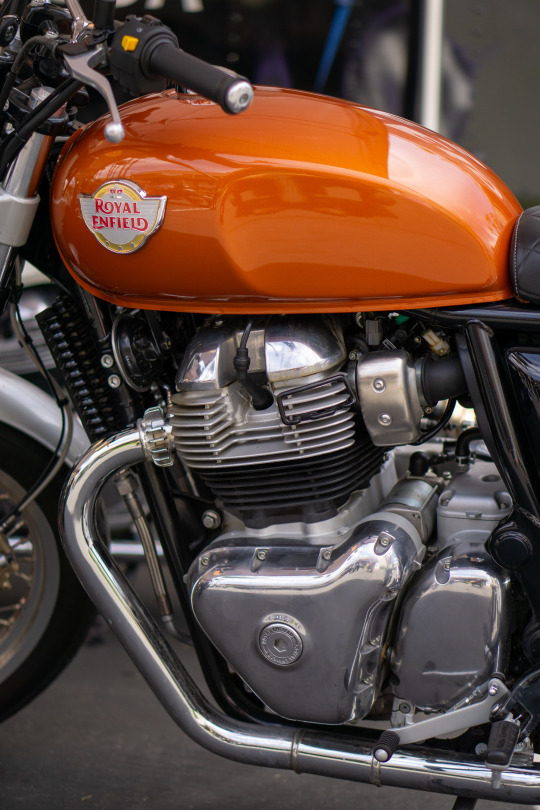
That 648 cc, single overhead cam engine that sent me hurtling through space and time happens to be the heart of the new Twins. With a torquey low-end power delivery, the engine boasts an exciting edge yet retains an affable disposition. Whether you’re running the Twins through their paces or cruising about town, the middleweight mill is happy to comply. For those hipsters looking for a CB750 or XS650, you no longer have to sacrifice reliability for aesthetics. The GT and INT 650 gives you the best of both worlds with smooth, efficient EFI fuel distribution and cafe racer styling.
In my short time with the models, engine heat never factored into the equation either. Even with that day’s temperature topping 90° F, the oil/air-cooled mule inside the Twins never skipped a beat, even when the pace hastened. Although Royal’s 650s did get up to interstate speeds without hesitation, I should note that both models feel more at home on surface streets. The torquey motor benefits the urbanite from stoplight-to-stoplight and the lack of wind protection would quickly fatigue riders on longer journeys.
Along with the punchy power delivery, the width of the frame, handlebars, and pegs allow the commuter to squeeze through the narrowest of spaces. I wish Royal’s Twins were on the market when I started riding because they’re great options for those just starting out, especially when it comes to the controls.
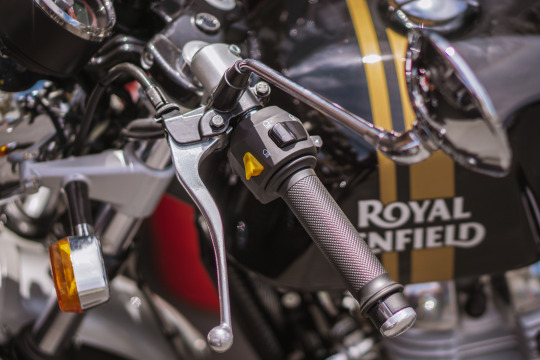
Like all of Royal Enfield’s lineup, the GT & INT opt for simplicity. The company tends to label its approach as “Purist” and a quick glance at the controls will drive that point home. Without the luxury of a TFT display, cruise control, or heated grips, the controls of the Twins are minimalist. That facet helps developing riders concentrate on the road instead of fiddling with menus and settings, allowing them to get comfortable with the clutch, throttle, and most importantly, the brakes.
Both models boast a single 320mm floating rotor with a two-piston ByBre caliper up front and a 240mm floating rotor clamped by a single-piston caliper out back. ByBre, the Indian subsidiary of Brembo, provides the braking components. I know what you’re thinking (Indian-made Brembos?), but the stopping power achieved with these “budget” calipers really do the job. Coupled with the 41mm fork and piggyback shocks, the braking system brings the hefty 450 lb bike to an even and controlled stop. Yes, neither component truly stands out on these bikes, when it comes to brakes and suspension, that’s usually a good thing!

It’s true that the INT & GT 650 share the same 648 SOHC engine, ByBre brakes, double-cradle steel frame, 41mm conventional forks, and coil-over rear suspension. However, they do differ in two major categories: aesthetics and ergonomics. The INT opts for a pseudo-scrambler look with high-rise handlebars (w. crossbar), bench-style seat, and mid-mount pegs. While the GT sports proper cafe racer cosmetics with clip-ons, single-seat (w. cowl), and rear sets.
Despite the ergo divergence, both the Twins handled responsively, although I wouldn’t call them lithe. The added girth of the larger engine means that the supporting package needs beefing up (compared to other Royal Enfield models). As a result, the 650s weigh more than any other Royal Enfield and the extra poundage is evident in the corners. I wouldn't label the Twins as unwieldy, but I also couldn’t praise them as flickable.
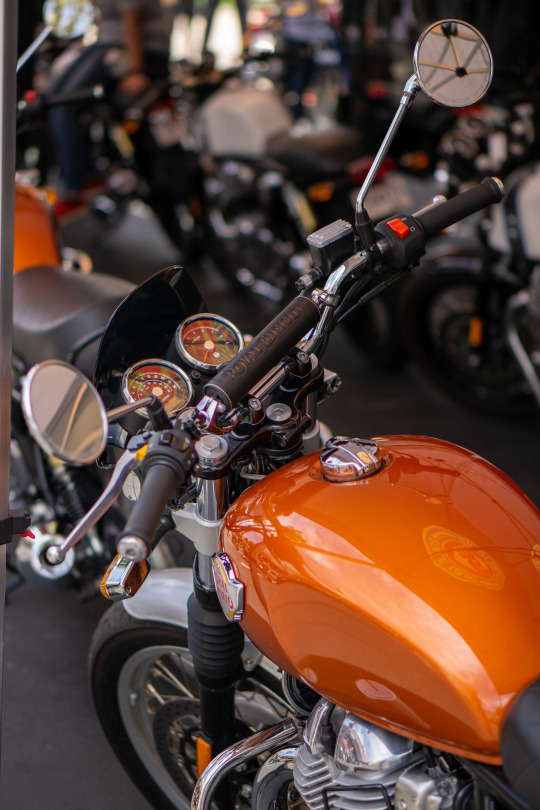
As a cruiser rider, the upright posture of the INT felt more natural, but the GT also proved the advantages of aggressive body positioning. With my abdomen lower to the tank, wind resistance was less of a factor and the direct input of the clip-ons resulted in a more reactive quality from the front end. Though the INT responded well to all of my inputs, I could dart through traffic on the GT (even if that feeling is primarily psychological - due to the ergonomics). For that reason, I think I’d side with the GT, as I’d primarily use both of Royal Enfield’s 650 in the city - and that’s where most consumers will ride these bikes.
With a base MSRP of $5,799, the GT & INT would be a viable starter bike for commuting students and city-dwellers. While most people warn novice riders against buying a 600+ cc motorcycle out of the gate, the 42 horses and 37 ft-lb of torque make the Twins manageable for newcomers.
The retro-styling of the models will definitely appeal to a younger crowd and the affordable price point keeps them within reach. New riders tend to focus more on the aesthetics, but they will inevitably drop the bike (...a few times) and a lower price tag always helps to cushion those falls. If I were in the market for a first bike now, I would seriously reconsider buying the Harley-Davidson Sportster Iron 883, and I LOVED that bike.

If you’re new to the sport or searching for your first bike, I’d strongly suggest a test ride of the GT/INT 650. The combination of aesthetics, price point, approachable demeanor, and simplicity make Royal Enfield’s Twins a very attractive package. Not to mention, the 3-year, unlimited miles warranty with roadside assistance, reinforces the build quality of these machines. Believe me, If the company released a dirt-capable twin at a lighter curb weight, I’d be all over it. While that’s irrelevant when it comes to these models, the experience wasn’t for not.
For me, Royal Enfields Twins were cheap, they were powerful, they just didn’t have taller suspension and knobbies that I’m looking for. Though I don’t plan to purchase the GT or INT 650, I learned that I will need my second bike to be commute-capable. The narrow footprint of the controls illustrated the importance of squirting through tight spaces in an urban environment. I guess my next bike will not only have to be cheap, dirt-capable, lightweight, and powerful but also commuter-friendly. I’m sure I’ll find that package in time, but for now, it’s on to the next bike!
#motorcycle#motorcycles#motorbikes#motorbike#moto#motos#motolife#test ride#Royal Enfield#RoyalEnfield#int650#int#gt650#gt#twins#royalenfieldtwins#royalenfield650#demo ride#first ride#first bike#firstride#ride review#MotorcycleDiaries#motoblog#motoblogger#writer#writing#theriderwriter#cafe racer#scrambler
72 notes
·
View notes
Text
TDSB: Episode 2, Part 1. Something Fishy This Way Comes...
*Cloud, Richter, and Stevie are in the Smash Bros Lounge watching TV. Cloud is reading, Richter is nursing a glass of wine, and Stevie is playing Candy Crush on his phone with the TV acting as background noise. Wario walks in on them lie this.*
Wario: What's up losers.
Richter: Screw off Wario.
Stevie: Aye mate! We're trying to get our hogwillies a rest 'ere ya humdinginer billabong!
Wario: Once I find out what that means I'll come up with a crushing reply.
*Wario plops down on the couch and grabs the remote, flipping through channels. Cloud looks up from his book, but double takes when he sees something familiar*
Cloud: Hold up! *grabs the remote from Wario*
Wario: Hey! What's the big i-
Cloud, flipping back through the channels: Shut up!
Stevie: Oi mate! What's got your bloomdingers in a sodfeelfen?!
Cloud: Look! It's Ganondorf! He's on TV!
*Sure enough all see Ganondorf on the television, now wearing a gaudy silver suit*
Richter: What the- he's right!
Wario: What the hell is going on here?! ...And why the hell is Ganondorf wearing THAT?
Ganondorf: Last time, on Total Drama Smash Bros! *cuts to the twenty contestants on the dock when they first arrived* Our contestants arrived here in Camp to compete in the greatest Reality TV show yet!
Cloud: That's all the Smashers that Master Hand called away on some secret mission!
Richter: Well now we know that's bullshit.
Ganondorf: *screen cuts to the Smashers joining their respective teams* After forming up and meeting their teammates, it was time for their first challenge, *shot of the contestants playing the game* VOLLEY-BOMB! *shot of Peach negotiating with Pit and Zelda* Alliances were made, *shot of Bonny Janet and Link arguing* strife was founded, *shot of Lucina getting blown away* and days, *shot of Falcon getting blasted* were, *shot of Corrine getting Warlock-Punched* Ruined!
Stevie: Oof, that's a right hard humdinger that is.
Ganondorf: *shot of Falcon getting thrown onto the Boat of Failures* In the end, it was Captain Falcon who was sent home for failing his team when they needed him the most.
Richter: Tough break Falcon.
Wario: But why the hell are they even there?! It makes no sense!
Ganondorf: *the screen returns to Ganondorf on the dock* Can the Goombas learn to trust each other? Will the Koopas learn about Peach's alliance? And who will win this week and find themselves one step closer to winning that sweet, sweet twenty million dollars!
Wario: TWENTY MILLION!?
Richter, clutching his ears: Well, there goes my eardrums.
Ganondorf: Find out this week, on Total! Drama! SMASH BROS!
Wario: I GOTTA GO!
Cloud: Go where?
Wario, jumping out the window and summoning his motorcycle: TO GET THAT TWENTY MILLION!
-----------------------------------------------------------------------------------------------------------
*The Campers are hanging out in the mess hall, chowing on breakfast crafted by Ridley.*
Robyn, holding up a chunk of “food” with her fork: Are we sure this is food? It seem more like something Godzilla would up-chuck if he had one too many beers.
Marth: I;m fairly certain this substances' mere existence violates the Geneva Convention several times over.
Link, chowing down: Meh. Not the worst thing I've ever eaten. *He takes another big bite as the others of his team look on in horror.* Mmh! Crunchy.
-
Confessional
Zelda: I know that Link has eaten some questionable things in his adventures, but I had no idea he had such an iron gut! It's terrifying!
-
Samus, shrugging and digging in: Eat up Koopas. Gotta get your energy up for whatever nightmare Ganondorf has planned.
Roy: Speaking of, where is that Sauron rip-off? *Roy suddenly gets smacked in the face by a Mr Saturn sending him into the wall connecting the Mess to the kitchen*
Ridley: Oi! I'm trying to work here.
Ganondorf, striding into the mess: Sorry my purple friend, but it's time for this week's challenge!
Roy: Everything... is... in pain...
Ganondorf: Move it or lose it Roy boy!
-----------------------------------------------------------------------------------------------------------
*Ganondorf has led the Campers to the docks where a series of boats await them. Half the boats are outfitted with Goomba red and the others are painted Koopa green.*
Ganondorf: Welcome to a little challenge I like to call... Man vs. the River Wild!
Samus: Let me guess... some sort of river rafting race with a brutal and sadistic twist to it.
Ganondorf: Eh, you're only half right. No to the rafting race, yes to the brutal and sadistic twist!
Ike: Figures.
Ganondorf: No, you're challenge is something different. *two moblins produce a large blackboard with instructions written all over it.* Ahem, as you can see, today you will be having a fishing competition!
Red: Seriously!? That's awesome! Leaf and I fish for aquatic Pokemon all the time!
Ganondorf: Today, your prize is the rare Spotted Buck-Salmon. *he holds up an example*
Lucina: Wait a minute, that just looks like a regular salmon you super-glued antlers onto!
*King K Rool, off to the side, slides a box of crappy dollar store antlers out of sight whilt whistling nonchalontly.*
Ganondorf: Regardless of their status as novelty items, you have to catch them! But be warned. These waters are filled with piranha, *Petey the Piranha Plant wearing a scuba outfit surfaces and waves at them.* sharks, *a shark pops out of the water and swallows Petey whole, grinning evilly afterward* and other unspeakable horrors from the depths that even H.P. Lovecraft would never be able to dream up! *a massive tentacle rises from the water and grabs the shark, dragging it down and causing it to spit up Petey*
-
Confessional
Link: Finally! Something I know I'm good at! I went fishing all the time in Hyrule.
-
Confessional
Ganondorf: In one of my many times trying to take over Hyrule I needed to find a way to delay Link. I tried two different strategies. First, I sent an army of undead after him, led by an Elder Lich. Secondly, I used a shovel to dig out a pit that a filled with water, stuck a “Free Fishing” sign in front of it while spreading the rumor that there was a rare fish inside.
One of those tactics bought me a whole month of time, and the other he beat in an hour.
Take a guess which one was which. Take a wild fucking guess.
-
Corrine: Okay, what's the horrible bullshit twist you've got for us this time?
Ganondorf: Aww, you know me so well.
*Corrine rolls her eyes*
Ganondorf: The twist? You can either catch the fish yourself, or wait for someone else to catch it and steal it from them!
Robyn: Wow, you're right. That IS bullshit.
Ganondorf, unperturbed: You have ten minutes to pick a partner to fish with and select which bait and tackle you'll use. Whichever team catches the biggest fish wins!
*the group splits up, partnering up with each other*
Dark Pit: Hey, dick knozzle! We've got an odd number of people! How are we gonna partner up?!
Ganondorf: Ah yes, well I guess one of your boats is going to have to hold three. *Peach immediately grabs Pit and Zelda, her hidden alliance members* Of course... those boats are only meant to hold two. Better be careful.
-
Confessional
Peach: I'll admit I'm not good at fishing. I always fail that minigame in Mario Party. But hey, Zelda and Pit both have to have some experience between them.
-
Confessional
Pit: Oh boy! My first time fishing! This is going to be so much fun!
-
Confessional
Zelda: Link took me fishing once... I caught something right away but... the poor fishy... *starting to cry* staring at me like that!
-
Peach: We'll handle it Ganondorf.
Ganondorf: Alright, whatever.
*The rest of the teams form. The Goomba Teams are: Daisy and Ike, Leaf and Red, Corrine and Rosalina, Joker and Marth, Link and Bonny Janet.
The Koopa Teams are: Zelda and Peach and Pit, Roy and Samus, Erdrick and Robyn, Lucina and Dark Pit*
Link: Hey does anyone want to trade? I'd rather not be teamed up with the Scottish Imp over here.
Bonny Janet: Blow it oot yer bagpipe!
Daisy: This could be a problem.
*Peach thinks for a moment and ten drags Zelda away to whisper in her ear*
Peach, whispering: When we're out there, I'm going to bring us up beside Link and Bonny Janet. Find a way to make tensions fly.
Zelda: I don't know Peach-
Peach: Link is the best fisher on their side! You have to, for the team.
*Zelda reluctantly nods. The teams are set! The battle begins...*
#incorrect super smash bros#super smash bros#incorrect quotes#Total Drama Smash Bros#Total drama#Episode 1#Part 1#Cloud#Richter#Wario#Pokemon Trainer#Stevie#Red#Leaf#Bonny Janet#Link#Samus#Marth#Corrin#Robin#Zelda#Pit#Dark Pit#Ganondorf#Daisy#Roy#Erdrick#Lucina#Fire emblem#Legend of Zelda
85 notes
·
View notes
Text
Crestfallen | Part Three
Pairing: Scott McCall x Female Reader (eventually), Stiles Stilinski x Reader (platonic)
Wordcount: 2k
Plot: You’re new to Beacon Hills, grieving your parents’ death. Scott befriends you in Biology class.
Chapter Characters: Natalie Martin, Lydia Martin, Stiles Stilinski, Coach Bobby Finstock, and Noah Stilinski; mentions of Isaac Lahey, Erica Reyes, and Vernon Boyd
Warning: Deep Angst. The reader’s character might come off as depressing to you. Real world AU - our beloved Alpha and Banshee are merely humans in this story.
A/N: First GIF isn’t mine. Got it from Google.
Part Two


It was almost November, roughly two months since I moved in with the Martins. Each day was getting colder. Gloomier. Lots of times I had thought about home. I thought about my friends Erica, Isaac, and Boyd. We weren’t the cool kids. And we certainly didn’t dream of being the cool kids. We were what you would consider invisible and happy with it. There weren’t defining cliques in our school. The four of us had our own world. And the one thing we all loved was Coldplay.
Isaac and Boyd worked at the local mechanic shop after school. Their thing was cars and motorcycles, but just like Stiles and Scott, they also had lacrosse to fill their afternoons and weekends. Erica loved going Star Trek conventions and more often than she should, to the hair salon. I, on the other hand, loved the movies. From the classics like Casablanca to pop culture ones like Pitch Perfect, I watched them all. I adore them all.
Sure, we had a common denominator. But we talked about lots of things. You know that kind of friendship that doesn’t need a reason to be together? That’s how we were. How we used to be. I missed them so much. But at this point in my life, I was not ready to face them. Is that weird? I missed them, but I didn’t wanna see them?
***
On the first week of the month, I didn’t know much about what was going on with me, but it sure got me to trouble. It was a dreading week in gym class and Coach Finstock was being a lot more annoying than usual. Such a loudmouth. He kept calling whoever was not as peppy as he was.

Unfortunately, I was one of those kids. Sometimes I mentally told him off, asking him what kind of teacher he is when he clearly lacks empathy or anything remotely close it. I mean, if a kid is less than energetic than other kids, what does that tell you?
I was getting annoyed by the way he kept snapping at me with his loud, phlegm-induced voice whenever he caught me just standing or sitting in a corner. No matter how loud he yelled me, he didn’t intimidate me at all. We had rock climbing and I didn’t want to participate. I was afraid of being up that wall, no matter how strong the harness was. There was no way I was going up.
“Y/L/N, everybody climbs! Now! Up you go!” He demanded. His voice was rough and loud, as always. I kept a straight face and didn’t move a foot. I already told him I didn’t want to go. I even explained how terrified I was of being up there. For some reason, his hostile temperament kept me calm no matter how I tried to explain and be firm with him.
I guess there was no way to reason with this guy. He turned his back on me when I thought I was still thinking, still trying to brace myself for that impossible climb, when I heard myself utter in my most sarcastic voice, “Up you go my ass.”
He turned around. He heard it. He heard me. Fuck.
“What was that young lady?” he threatened. My lips were sealed. But my eyes were screaming murder. “What? You’re mute all of a sudden?” He was chuckling now, enjoying this very moment of my embarrassment. Everybody was looking at us now. At me. I glared at everyone around us, looking at me. “Look, Y/L/N, I haven’t got all day. Detention. NOW.” I inhaled deeply and turned around. I could still feel my eyes murdering him. But somehow I was relieved for not having to climb that wall, but also just a tad bit worried about what Natalie would say. For sure, it was gonna be something I don’t wanna listen to.
I spent an hour in detention scribbling all sorts of profanity that I was screaming in my head. I drew trees. Lots of it. And they were all terrible ones. I’m no artist, that’s for sure. That whole hour, I realized how good Lydia and her friends were as students. They always had things coming and going. I think they were never in detention. I thought of them as my hand drew lines in my notebook.
Scott was getting mostly A’s in AP Biology. Two weeks ago, he started using big words like “ephemeral” in normal conversations. Everyday, he had a new word. I found it pretty funny, actually.
Meanwhile, Lydia got busy with her Math and Science clubs. There was an inter-school math olympiad competition coming up, and a science fair for middle schoolers that the high school Science club had organized. Stiles wasn’t academically competitive compared to the other two, but he devoted some of his free time helping out his dad at the police station. He’s so smart about detective stuff, I think he might join the police force in the future.
They’re such good kids. Sometimes I felt ashamed hanging out with them. Especially that Lydia is family. There’s always that thing. The chance to be compared to her. Anyway, I enjoyed detention. I was away from everybody. But as soon as the bell rang, my fun ended as well.
When Lydia and I got home, I rushed up to my room and buried my face to the bed. I felt like time was passing so fast that I could already picture Natalie’s face frowning at me. Judging me. The next thing I knew, Lydia was waking me up for dinner. I basically slept for two hours trying to escape this shithole I seem to have dug myself into.
I wasn’t wrong. I was bound to be confronted about my recent behaviors in school.
“I heard you were giving Coach Finstock a hard time today, Y/N,” Natalie began. I knew it. They pick up on trouble like fucking hound dogs. She didn’t even just call me to her office and waited ‘til all of us got home before she decided to do this talk. In front of the food. In front of my perfect cousin. I just looked at her as I picked on my food with my fork.

“He’s the one who gave me a hard time. I didn’t wanna climb.”
“How do you expect to be graded if you don’t participate in class? And speaking of which, Principal Thomas told me you’ve been skipping classes, too.” I didn’t say anything back. I’m surprised she hasn’t noticed when she herself was in school every day as well.
I also didn’t look at her. But I could already feel my face heating up. Lydia’s wide eyes were on me too, of course. She didn’t know I was in detention. If people’s bodies appeared literally the way they felt, then my head must be burning now.
“You better fix that attitude, Y/N,” Natalie commanded.
“OR WHAT? What are you gonna do, huh? Tell my parents?!” I don’t know why I said that but it just came out. My heartbeat was picking up and I wanted to scream at her. Instead, I stood up quickly before she could say anything back and rushed to my room and locked myself in there.
I badly wanted to run away. No. I wanted to disappear.
That night, Natalie tried to talk to me. She knocked a few times but my lights were already off and of course, I pretended to be asleep. The next morning on the ride to school, Lydia and I were silent as dead people in a graveyard. I was still cranky from the night before. I probably looked like I could kill someone with just a look in the eye.
***
Stiles and I agreed to meet after school for another History project. I asked him if we could go to his house this time. I didn’t want to come home early. I told Lydia I would be with Stiles. I guess she hated my guts so much that she didn’t even bother hanging out with her boyfriend for a while.
Our History project involved a lot of research and analysis for a thorough report and debate due the following week. Talk about making things complicated. Our discussion started at 5 PM and ended at around 8:30, when his dad had just arrived from the station, bringing us dinner. We were so into our discussion that we totally forgot about dinner.

An hour later, Sheriff Stilinski was already drowsy from drinking half a bottle of Jack while he studied cases from the station. He was talking to himself, trying to understand them. I watched Stiles get stressed over his dad. They would bicker just about anything, especially about food. At times, they forget I was around that they would exchange roles of being the parent and son in the room. Sometimes I found them amusing and sometimes I found things between them sad. A better term would be ‘bittersweet’. I never got to know this side of Stiles. I thought he was all sarcasm and jokes and the daily avoidance to face life’s shit. But here he was. Facing life’s shit daily.
He and his dad take care of each other. His mom passed away when he was young. Stiles had always made sure his dad ate well. Even though he allowed him to drink at night sometimes - just to soften a hard day’s work. Anticipating the day to come for another hardball to play was another thing, I guess. A drink, indeed, was necessary.
That night, Stiles caught his dad finishing a whole bag of fries from the takeouts. Of course, it was too late for anything except him scolding his dad about hypertension. After putting him to bed, he went downstairs mumbling, “People say it’s difficult to raise kids. But did they ever think of kids who try to raise their parents?” It was almost 9 PM and we just wanted to patch up a few details before calling it a night.
He offered to drive me home in exchange for finishing later than agreed. If I were to decide, I would say he needed the drive too. We were mostly quiet during the ride home. But I was comfortable with it. I wasn’t pressured to talk about anything. Stiles became someone so easy to be with. Perhaps that’s why, when he pulled over at the Martins’, I blurted out something that’s been in my head for a while.
“You’re lucky you still have your dad, Stiles,” I quietly said. He looked at me with the expression he’s never showed me before. I believe the word for it is ‘concern’. If not pity.

“I’m sorry, Y/N/N,” he muttered. I guess it was ‘pity’ then. “I shouldn’t have complained. It just...gets really difficult sometimes.” It turns out, I judged him for pitying me. When did I become so snobby and judgmental?
“No. I’m sorry,” I insisted. “I didn’t mean for you to compare your life to mine. I’m just...I know I’d do the same if I were in your shoes. It’s not like we have a choice, right?”
He looked at me in the eyes almost without blinking. I could tell he was thinking of what he wanted to say to me. But instead, he gave me that sad smile I’ve been seeing everywhere - from almost everyone I spoke to. I didn’t resent him for that. His mom died too. I can’t imagine growing up without my mom. And he did. And he became this really strong person he probably doesn’t even know he is. Since then, I never looked at Stiles the same way. He was a responsible kid, no matter how strongly he wore that clown facade. He has earned my respect that night.
If one of my parents were still alive, I would do what Stiles does. I’ll make sure they live longer than they expect themselves to.
Part Four
@bojabee @jurrasicpork @thejourneyofabrokenheart @sav625 @kim-hunter5 @seninjakitey
#stiles stilinski x reader#scott mccall x reader#teen wolf imagine#teen wolf au#scott mccall angst#teen wolf x reader#scott mccall#stiles stilinski
64 notes
·
View notes
Text
Yezdi Adventure: A Tourer NOT For The Faint Hearted
Yezdi is a name that can hit the right nostalgia in the hearts of motorcycling enthusiasts and millennials. Classic Legends has revived the brand in India and has brought in some of the most iconic motorcycles. One such is the Yezdi Adventure. This adventure motorcycle is everything that one needs to take on the roads less traveled. Here’s my experience with the Yezdi Adventure.
- A Design That Exudes Adventure
At first glance, the Yezdi Adventure captures attention with its purposeful design that signifies its off-road prowess. The motorcycle features an aggressive stance, a high-set front fender, and a tall windscreen that showcases its readiness to tackle any terrain. The combination of a muscular fuel tank, knobby tires, and a raised ground clearance further amplifies its rugged appeal. Whether it’s traversing gravel roads or conquering uneven trails, the Yezdi Adventure stands out as a true adventure companion.
-Commanding Performance on Any Terrain
Equipped with a powerful engine and capable suspension, the Yezdi Adventure ensures a thrilling and confident ride across various landscapes. A powerful 334cc, single-cylinder, liquid-cooled engine with plenty of torque and power is tucked away beneath the motorcycle’s durable chassis, allowing it to take on both on- and off-road obstacles.
A smooth ride over uneven terrain is guaranteed by the suspension system’s precisely adjusted front telescopic forks and rear dual shock absorbers, which offer great stability and control. With the Yezdi Adventure, riders can confidently tackle dirt trails, and rocky paths, and explore the unknown with adrenaline pumping through their veins. I have been able to traverse through unchartered territories on this adventure motorcycle with ease.
-Designed for Endurance and Practicality
The Yezdi Adventure has all the necessary components to meet the durability, dependability, and practicality requirements connected with adventure riding. Its robust design, strengthened chassis, and premium parts allow it to withstand the rigors of off-road adventures. Long hours of exploration can be done without growing weary because of the ergonomic seating position. The motorcycle’s large storage capacity also enables riders to bring the necessary supplies and equipment for their trips. The Yezdi Adventure is more than simply a motorcycle; it’s a trusty travel companion designed to withstand the difficulties of exhilarating excursions.
-Unleashing Boundless Exploration
I am no longer limited to paved roads or well-known routes with the Yezdi Adventure. This motorcycle evokes the spirit of adventure and invites me on a journey into the unknown. The Yezdi Adventure is a tribute to the freedom and thrill that lies beyond the conventional, from navigating harsh terrains and mounting mountain paths to engaging in cross-country adventures. It always motivates me to test their limits, enjoy the excitement of off-road riding, and make amazing experiences amid nature’s vastness.
Overall, it has been an exhilarating experience driving one of the very few adventure motorcycles available in India. Yezdi Adventure has been my companion to going on drives that bring back the nostalgia. Being classic and stylish while also having inherent ruggedness has made it the best choice for anyone looking for a weekend away from the urban jungles and driving amongst the roads that lead to peace and serenity.
0 notes
Text
A Motorized Bicycle is the Future of Tomorrow - Available now at Phatmoto
Bicycles and motorcycles have taken the place of cars in the market since the 1990s. Are our behaviors the same today? We are simply using the fuels that are now available while taking into account our advantages. Fuels like gasoline and diesel are bad for the environment. After this, environmental issues will still exist. Global warming, the most crucial problem of our day, has a tremendous impact on the ecosystem and alters nature in many ways, including temperature.

Don't worry; Phatmoto provides you with reasonably priced options for both their gas motorcycle and green bicycle. Promoting environmental preservation is well recognized for Phatmoto's motorcycles and gas motorcycles. We will go through every characteristic of Phatmoto gas motorbikes and bicycles in this article. Gas powered bicycle, bicycles with gas motors, and bikes with gas motors that don't cause pollution are all inventions of Phatmoto.
What's Special about Phatmoto's Bicycle with a motor?
Our specially crafted gas bike has an engine or pedal propulsion and can go up to 100 miles at a speed of 25 mph on less than a gallon of fuel. Phatmoto is far from your typical motorized gas-hybrid bike since it conceals a lot of helpful engineering characteristics behind a conventional bike frame. Attach the handlebars and front wheel to Phatmoto's fully outfitted a motorized bicycle, put some gas in it after a quick engine assembly, and you're ready to go.
What are the ultimate features of a motorized bicycle by Phatmoto?
ALL NEW Shimano 7-Speed Gears
Phatmoto Hilliard Heavy Duty #35 Clutch 12 Tooth
Integrated Gas Tank Frame
Built-in Frame Upgraded Jackshaft
160mm Front Disk Brake
Rear Disk Brake
Suspension Front Fork
79cc - 3.0 Horsepower 4 stroke Lifan engine
100 miles per full tank
Available in 2 colors
It comes with removable Front and Rear Racks
What Is Phatmoto's Philosophy for producing such a bicycle with a motor?
Cycling is recognized as one of the healthiest activities you can engage in since, among several other health advantages, it may increase your fitness, bolster your immune, and improve your mood. Phatmoto is working with a vision to make quality, affordable & accessible solutions for society that can also benefit our environment.
But do electric bikes offer the same health advantages? Some argue that riding an e-bike requires more exercise to reap the same health benefits as walking or running. But that isn't true at all! Here are the top health advantages of using an e-bike more frequently than you might anticipate.
What benefits of E-bikes or Motorized bikes?
The motor for bikes made by Phatmoto is full of health benefits that might surprise you.
E-bikes offer a light kind of exercise
Couples are riding an e-bike across the country or demonstrating their health benefits. An e-bike is fundamentally just a pedal bike, which most of us learn to ride as children. You begin, ride, and end a ride precisely the same way; the only difference is that you now have a motor to help with some of the work.
Increased cardiovascular fitness
We frequently hear from experts that enhanced general health is a common advantage of modest exercise. Yet cardiovascular health is one of the key advantages.
Better heart health
Regular use of a Phatmoto bicycle with a motor can lead to heart health benefits and cardiovascular health improvements. When you exercise, your heart works a little more, beating faster and harder to keep the blood flowing. Because your heart is a muscle, it will become more accustomed to this stimulus the more you train it.
Enhanced muscular tone
If you are one of those who demonstrate the health advantages of riding an e-bike on a route. So, Phatmoto's motor for bikes is just the best for you. Although you can't see your heart getting more substantial, you may see changes in your body's muscular tone, especially in your legs.
What's More!
The fact is that we spend money on vehicles for the sake of our convenience, neglecting the betterment of our environment. But Phatmoto is here to take care of our customers & environment in the same place. That's why we have put our heart into making a motorized bicycle that will not only give you satisfaction and help you stay healthy but also be safe for you & environment as well. So, don't think much & order it now.
1 note
·
View note
Photo

The Velocette 500 Thruxton STORY BY GRAHAM CLAYTON// PHOTOS BY GRAHAM CLAYTON OCTOBER 1 2009
1967 Vintage Velocette 500 Thruxton Motorcycle The first time that I ever saw a Velocette Thruxton was at a road race at Harewood Acres, a long-since-gone converted airfield circuit near Delhi, Ontario. The Velo’s owner had parked it in the paddock and wandered off to watch the fairing bashing going on through Gunnery Corner. To me the 500 Velo was pure eye candy.
The Thruxton had the purposeful look of a true road burner, albeit with a decidedly dated looking engine. Sometime earlier I had read a road test on the model in Cycle World, so I knew what I was looking at and what the 500 cc bike was capable of. Little did I know at the time that the Thruxton model would be the most advanced, and also the final version of the high-cam Velocette OHV single.
The history of Velocettes is also the history of a family motorcycling business that would span three generations. The company’s founder, Johannes Gutgemann, was a German immigrant who settled in the Birmingham area in the West Midlands of England. Initially, Gutgemann went by the Anglicized name John Taylor, and by 1904 was building motorcycles in partnership with William Gue. Their bikes were sold as Veloce motorcycles. This early venture failed in 1905, but Taylor went on to form a new company of his own, Veloce Limited. Taylor had two sons, Percy and Eugene, who were both very capable engineers. In 1908, the two sons started their own firm, New Veloce Motors, which would build cars, as well as small displacement engines that would power motorcycles built by their father’s firm ,Veloce Limited, located in London.
In 1909, Veloce introduced a 276 cc 4-stroke single of non-conventional design that didn’t sell well. The firm responded by offering a new 499 cc model powered by a more standard design 4-stroke single with belt final drive. This model was a market success and sales began to grow.
In 1911, Veloce launched a small displacement machine that was designed for ladies. Powered by a 206 cc 2-stroke engine, this model was the first to carry the Velocette name. That year Gutgemann took out British citizenship and changed his name yet again, this time to John Goodman.
By 1916, New Veloce Motors had failed, but was absorbed into Veloce Limited as its in-house engine operation. Over the next decade, the Veloce Motor Company introduced a variety of new models using different engines designed by the two brothers. What became evident was that the brothers had quite different design interests. Percy was into high performance and racing models, while Eugene was focused on the design of more basic and utilitarian models meant for mass consumption. This dichotomy of design interests persisted for years at Velocette and taxed the resources of the small firm.
In 1925, Percy Goodman designed an OHC 348 cc sports prototype that was designated as a K model and badged as a Velocette. Three of the new K models were entered in the Isle of Man Junior (350 cc) TT road race, but didn’t do well. The following year a revised KSS model was entered in the Junior TT and it won. Thus began a period of racing works 350 cc OHC Velocette TT singles that would span twenty-five years. Velocettes would win the 350 cc Isle of Man Junior TT again in 1928 and 1929. As a result of those wins, Veloce began selling a new over-the-counter 350 cc racing model, the KTT, that would become hugely popular among privateer racers and would dominate 350 clubman racing for the next decade. The 350 KTTs would win the Isle of Man 350 Junior TT again in both 1938 and 1939.
When postwar road racing resumed in the Isle of Man in 1947, works 350 KTT riders won the 350 Junior TT for three years straight. Not only that, but when the FIM Grand Prix World Championship series resumed in 1949, Velocette won back-to-back 350 GP World Crowns with KTTs ridden by Freddie Frith in 1949 and Bob Foster in 1950. Freddie Frith was an incredible 40-years-of-age when he won his 350 cc World Championship, and promptly retired from racing. During the twenty-year period, 1930-1950, the Veloce Motor Company designed and built a variety of different motorcycles powered both by 2-stroke and 4-stroke motors. Mainstay models that sold well through the 1930s included the 248 cc MOV (1933), the 349 cc MAC (1934), and the 495 cc MSS (1935). Each of these models incorporated a high-cam, short pushrod layout that became standard on all of the road-going Velocette 4-stroke singles, including the later Thruxton.
Once the war was over, Velocette began reintroducing their road-going OHV single models.
Unlike some larger competing British firms, Veloce had produced few bikes for the war effort, and had to struggle to get back on their feet when peace resumed. Veloce was always a relatively small firm and never employed more than 400 workers. Their machines were much more hand-made than those built by their competition, a factor that contributed to their higher price tags. If Veloce had focused fully on moving ahead with updated road-going singles in the early postwar years they would likely have recovered their pre-war market strength, but this didn’t happen. They tried to do more than their modest resources could support and suffered for it.
Percy Goodman died in 1951 at which point the Velocette works race shop was closed.
By now brother Eugene had introduced a new model, the LE, for which he predicted large volume sales. The ungainly LE employed a pressed-steel frame and came fitted with running boards and leg shields. It was powered by a 149 cc water-cooled, side-valve, horizontally opposed flat twin with shaft drive. The engine had to be cranked to start and employed a hand gearshift. Not surprisingly the public didn’t go for it, though it did prove popular as a local police bike. Even so, sales were barely one fifth of Eugene’s expected volume. It should have been dropped, but wasn’t.
In 1956, responding to market demand for bigger and better bikes, Veloce introduced two new sports models, the 500 Venom and the 350 Viper. The Venom was capable of 90 mph (145 km/h) and could easily be upgraded for racing use. From 1960 onward both models were also offered as Clubman models with lowered bars, tuned engines and upgraded suspension for high-speed use. The Venom Clubman proved to be a popular model and performed very well in endurance racing.
In March of 1961, the factory took a team to France for an attempt on the 12-Hour and 24-Hour Speed Records for a 500 cc machine. The venue for the attempt was the banked Montlhery circuit outside of Paris. The company’s up-rated 500 Venom Clubman succeeded in setting a 12-Hour Record at 104 mph (167 kph) and a 24-Hour Record at 100.05 mph (161 kph). These results cemented the reputation of the Velocette Venom as a fast and durable machine. In 1964, the firm introduced a special version of the Venom Clubman with a new cylinder head, narrower valve angle, larger inlet valve, revised intake and a large Amal GP carb that in order to fit necessitated cutting a notch in both the gas tank and the oil tank. The new machine won the 500 class of that year’s gruelling Thruxton 500 mile endurance race giving rise to a new model introduced the following year.
This model was the Velocette Venom Thruxton introduced in 1965, a genuine ton-up café racer for the serious enthusiast. The Thruxton had a new cylinder head based on a squish-type design that had been developed by Lou Branch, Velocette’s U.S. importer. It incorporated a two-inch down draft intake, a larger intake valve, a high performance camshaft and a higher 9.2:1 compression piston. Fitted with a 1 3/8” Amal GP carburetor, the standard bike produced 40-41 bhp at 6,200 rpm, and was good for a top speed of 105-110 mph (169-177 km/h) in stock form.
The Thruxton came with clip-on handlebars, rear-set foot pegs, a humped leather racing type seat and a notched 4.5-gallon fuel tank. Other features of the model included separate stand-up speedo and tachometer, a sweptback header pipe and a traditional Velo fishtail muffler.
The frame employed was a standard Venom dual loop unit with a single front downtube, fitted with upgraded telescopic front forks and dual Girling shocks at the rear. As with other Velos, the angle of the rear shocks could be adjusted to accommodate varying passenger loads by making them more vertical for heavier two-up riding.
The bike ran on 19-inch alloy rims front and back, fitted with a 3.0” x 19 front tire and a 3.5” x 19 rear. Stopping power was provided by a 7.5” (190 mm) diameter double leading-shoe front drum brake with an air scoop and a 7.0” (178 mm) single leading shoe rear brake. The bike had a fairly hefty dry weight of 390 lbs. (177 kg) and a wheelbase of roughly 54 inches (1.37 m).
As with any high performance, large carb single of the day, starting required adherence to a set procedure if trouble was to be avoided. This typically involved tickling the carb (flooding the float chamber), easing the piston over compression with the use of the compression release, setting the throttle opening, and then giving a good non-stiff-leg downward kick on the kick starter. A well set-up bike would usually start with 1-3 kicks.
Being a non-counterbalanced single, vibration was a fact of life with the Velo, but back then most big bikes vibrated. At idle the front wheel would dance a bit, but once underway the vibration was not a problem, and would disappear above 4,500 rpm, which made the bike a comfortable high speed cruiser.
Fitted with standard gearing, the Thruxton would be pulling only 4,000 revs at 70 mph (113 km/h), and could cruise indefinitely in the 80-90 mph (130-145 km/h) range. More than a few British 650 twins of the day found staying with a 500 Thruxton hard going at speeds above 80 mph.
The one clear chink in the Thruxton’s armour was its ability to overrun its headlight in high-speed night riding. The Velocette electrical system was 6-volt which yielded a relatively yellow and weak light output.
The high speed and good handling capabilities of the Thruxton were proven repeatedly in race competition. A Velo Thruxton team won the 500 cc class of the 1965 500 Mile race, run that year at the Castle Combe circuit in Wiltshire, England. Then two years later, a pair of Velocette Thruxtons finished first and second in the 500 cc class of the inaugural Isle of Man Production TT race. Race winner Neil Kelly averaged 89.89 mph (144.7 km/h) for the distance with the fastest lap at over 91 mph (146.5 km/h), while second place finisher Keith Heckles had a race average speed of 89.15 mph (143.5 km/h).
A tweaked production racing Thruxton could produce a further 5 or 6 bhp over stock and, when fitted with a full fairing, could top 120 mph (193 km/h). Later model Thruxtons were fitted with a concentric type Amal carb, a higher compression piston, and from July 1968 onward had the traditional Velo flywheel magneto system replaced by a battery and coil ignition (still 6-volt) that was reportedly a lot easier to live with.
In early 1969, the British motorcycle weekly Motor Cycle ran a road test using a staff member’s up-dated Thruxton. Two of the things that really struck the testers about the 500 Velo was its tractability and its fuel efficiency, something that they hadn’t expected from a big single fitted with a GP carb.
The testers reported that the Velo had a non-lugging speed of 28 mph (45 km/h) in top gear, and could paddle along all day at 3,000 revs. Fuel economy testing revealed the following remarkable results of 96 mpg at 30 mph, 70 mpg at 50 mph, and 57 mpg at 70 mph. These were the type of fuel economy results than you would typically get with a good 250 cc machine in the late 1960s, not a built-for-speed 500.
Production of the Thruxton continued until late 1970 by which time Veloce was financially on its knees. Far too much money had been spent on the various LE variants which drained cash from the firm, plus other abortive designs. The last of these was an unsuccessful 250 cc 2-stroke, flat-twin scooter called the Viceroy. It was hoped that this model would enable the firm to cash in on the scooter craze.
In the final years of Veloce Limited, two of John Goodman’s grandsons were managers of the firm. After sixty-six years in the motorcycle business the family voluntarily closed the company in February of 1971.
By then the firm had reportedly produced some 1,108 Thruxtons, half of which were exported, with over two-thirds of those coming to North America. Most of the Thruxtons were fitted with a silver and blue pinstriped fuel tank, but from 1967 onward the model could also be specially ordered with a more traditional black with gold pinstripe Velocette tan
6 notes
·
View notes
Text

Bike suspension improves control, traction, and comfort on bumpy, rooty highways or singletrack. It is just one of many elements that go into how much fun you have while riding. This article explains the fundamentals of suspension for anyone looking to buy a new bike or considering an update. We then provide a more thorough explanation of how suspension functions.
A shock absorber's job is to keep the remainder of the car from moving too much while the wheel(s) follows the road's curves. Pneumatic tyres continue to handle most minor vibrations (buzz), which are still required for a secure and comfortable ride. Larger terrain imperfections can be "flattened out" with the use of a Yss shock absorber (Yss suspension). What makes them do that? through contracting and enlarging. This dramatically reduces the impact of potholes and bumps because it allows the wheels to move up and down in relation to the rest of the vehicle. Additionally, they have a damping effect (more or less), such that the following compression, they expand back to the predetermined position somewhat gradually rather than abruptly.
Main Suspensions on a motorcycle
1. Front Suspension
The front suspension's operation is rather simple. Springs and dampers of some sort are a part of every suspension system. The dampers regulate the spring oscillations while the springs support and cushion the car as it drives over bumps in the road.
a) conventional Telescopic Fork
The most popular front suspension mechanism is a set of telescopic forks. The setup is very straightforward and comprises of lengthy hydraulic tubes with an internal coil spring. These forks' tops are attached to the motorcycle's frame using a T-clamp, and their other ends are attached to the front wheel's axle. When there are road defects, the lower portion of the fork bodies slides up and down the fork tubes, absorbing the vibrations. To ensure smooth operation, the inside is filled with oil, which is sealed inside by an oil seal.
b) Upside-down fork
Forks that have been set upside down or inverted are simply regular telescopic forks. These have the tubes at the bottom and the slider bodies at the top. These are now mostly utilized in high-end motorcycles because they increase torsional rigidity and reduce the motorcycle's overall unsprung weight, which improves handling.
#yss suspension keala#hiflofiltro#rk chains and sprocket#air filters for motorcycles#bs battery#excel asia rim#two wheeler chain sprocket price#dp brake pads#venhill cables#yss suspension#speedmottorad
0 notes